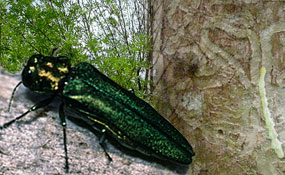|
COLUMN
 Borers
and their control Borers
and their control
By John
Fulton
 Send a link to a friend
Send a link to a friend
[May 08, 2014]
Few things strike fear in the
hearts of tree owners like the mention of borers. Borers are most
often the larvae of beetles or moths, and they do their damage where
you can’t see it. The eggs are laid on or under the bark, and the
small hatchling chews through to the part of the tree they feed on.
They spend almost their entire lives inside the tree, where they
can’t be seen or controlled.
|
|
 May 24-30 has been selected as Emerald Ash
Borer Awareness Week because it coincides with the time of year that
the adult beetles will begin to emerge. These borers have gotten a
lot of press the past few years, and have made ash trees undesirable
for planting. They are metallic green, about a half inch long, and
make “D” shaped exit holes (unlike the ash borers we have had around
here for many years which make “O” shaped holes). May 24-30 has been selected as Emerald Ash
Borer Awareness Week because it coincides with the time of year that
the adult beetles will begin to emerge. These borers have gotten a
lot of press the past few years, and have made ash trees undesirable
for planting. They are metallic green, about a half inch long, and
make “D” shaped exit holes (unlike the ash borers we have had around
here for many years which make “O” shaped holes).
Most borers are named for their primary target,
but they also affect other species of trees and shrubs. As an
example, the flat-headed apple borer can also affect pin oaks and
about 15 other species. Many borers leave a tell-take hole in the
trunk, but some such as the ash borer are weak and have to enter
through a pruning or mechanical injury.

Here is a listing of common borers and their
control times: Common ash borers (early June and early July),
emerald ash borer (mid May through early June), bronze birch borer
(mid May and repeat two times at two week intervals), dogwood borer
(mid May and mid June), flatheaded apple borer (late May and repeat
in three weeks), lilac borer (early June and early July), locust
borer (late August and mid September), mountain ash borer (early
June and mid July), peach tree borer (mid June and mid July),
viburnum borer (early June and early July), and Zimmerman pine moth
(April or August).
You can see borer control isn’t an exact
science. Treatment times and re-applications are hopefully timed to
catch the hatching eggs on the outside of the trunk, or discourage
the adults from laying eggs. Some new research shows that trees that
are under stress give off a certain pheromone that attracts more
borers to the tree. So, keeping your trees in good growing shape
will go a long way to helping the situation. Fertilizing with the
same rate of broadcast fertilizer used for lawns will help (apply it
early May and early September), and watering during extreme dry
periods as well (with an inch of broadcast water per week.
[to top of second column] |

Some of choice for borer control include
permethrin, bifenthrin, and acephate. Check the label for
control on your target borer. Imidacloprid is fairly new on the
market. One trade name is Merit (one example sold for homeowners
is Bayer Advanced Tree and Shrub Insect Care). This product use
rate is an ounce per inch of circumference of the tree trunk.
You then mix it with three gallons of water and pour around the
base of the tree. It may take a few months for it to translocate
though the tree. A good time to apply it is in early spring when
the sap rises. Each treatment lasts about a year. Fruit trees
generally are treated differently with Sevin, or just using the
regular spray program due to the possibility of residue in fruit
Zimmerman pine moth is one of those “kind of
borers.” It generally affects only severely weakened trees, and goes
just under the bark to girdle the cambium layer. It seems like older
Scotch, red, and Austrian pines are favorites when they begin to
decline. Bird damage from yellow bellied sapsuckers on trunks and
main limbs also looks like borer damage to many. This bird damage is
easily recognized by the evenly spaced holes in a straight line.
[By
JOHN FULTON,
University of Illinois
Extension director for Logan, Menard and Sangamon counties]
 |